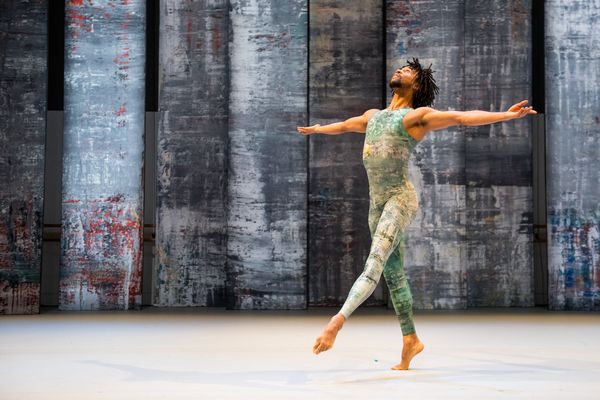Phillips: What was it like working with Merce Cunningham and what are your fondest memories of that experience?
Jeannie Steele: I worked around him from the age of 18 to 36 so there are almost too many memories to choose from, but I think in terms of the actual working environment it was amazing to see his glee and happiness when he would find something new to work with — making a discovery in the studio, for instance, would literally make him giddy.
P: Was he one of those people who had a great sense of curiosity?
JS: Absolutely, and he was fascinated by all types of movement. He was very much into people-watching, animal-watching — there are pieces of his based on animal movements — and even the movement of a ship, perhaps, going by, in contrast to the speed of what was going on in the studio. Those types of contrasts fascinated him. And his curiosity never wavered until the very end: he was always trying to find ways to create new movement. I think his curiosity for movement really filtered down through the whole company as well as his courage to try new things.
My fondest personal memory of Merce was being with him the day before he passed. He had sort of rallied in his last week and was actually feeling relatively well, and we spent time speaking about how we might move forward in terms of his creative work. He was never fearful of change, so I learned from him to always embrace change and to always try to move forward.
Merce was an incredibly spiritual man, I think. People don't really realize that because his work is quite structured and rigid in some cases, but as a man and artist he believed in dance and technique as an expression of that individual's spirit. So as I stage works and teach the technique, I always make this a fundamental rule — any structure or study is a means to expressing the person who you are, not the body you are.
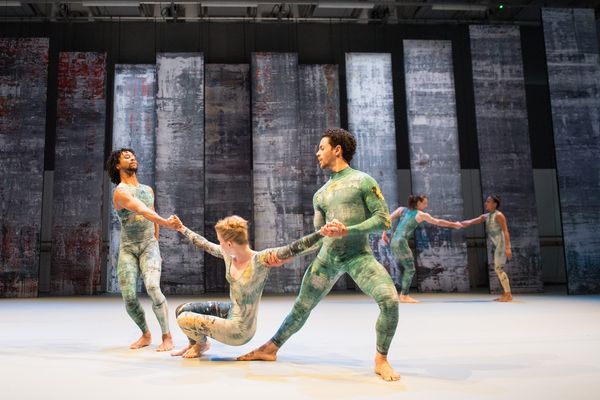
P: Cunningham famously suggested that the choreography, design and music for his works should be created independently, coming together only for the moment of performance. For you, what do you find exciting or even challenging about working in this way?
JS: It's kind of like opening a birthday present. You might have some idea of what you're getting, but it could be entirely different. And when you worked around him, he gave you courage to embrace that kind of thing — not to fear the outcome but to be in the moment. In the studio, you might have a very definite idea of what you think a piece is going to be and then you get on stage and you have this completely altering experience. It's thrilling! It's always this feeling of expansion.
There was one piece we did called Interscape with beautiful Rauschenberg decor, and in the top corner was a white duck. And there was a very dark moment on stage when we were sort of arched over looking up, and I had to use the duck or else I would fall over. I always had this joke with Merce that without that duck I wouldn't be able to stand up — so thank you Rauschenberg for placing that duck right there.
P: That certainly sounds like living in the moment!
JS: Definitely, and there was a feeling of aliveness with those types of collaborations because it could be different every time. It kept our relationship with the work and each other very fresh. There was also room for us to be human and to have a human experience because of that openness and collaboration.
I want the audience to have a feeling of the texture of Merce's work — it's such a vibrant, dynamic palette.
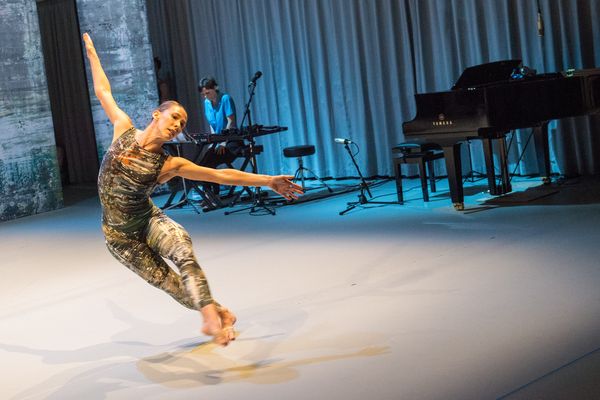

P: That's such a generous way of working. In terms of staging this Rambert Event for Phillips, what has your creative process been like so far?
JS: Right now the dancers are coming back from holiday, and I'm really trying to imagine how the audience at Phillips is going to experience this performance. It's going to be a very different set-up for us, and it's a more intimate space so the dancers will have to be more precise and specific in their movements relating to the new size of the stage. Aside from the technicalities, I'm really hoping to take the different sections and find a flow for them, moving from a strong group segment into a softer solo, for instance, so the audience has a feeling of the texture of Merce's work — it's such a vibrant, dynamic palette.
P: And how familiar were you previously with the art of Gerhard Richter? What qualities in his painting stand out to you and how do they influence the movement of the dancers?
JS: As I was just describing Merce's work as very textural, I think Richter's paintings also possess a movement, vibrance and flow. Working around Merce from the age of 19, my education wasn't just in dance but in all forms of art through the collaborations he developed.
Of course the Cage paintings at the Tate Modern were always a point of reference for us, and a place we would visit often when we came to London on tour. I also like the fact that they're on the South Bank where Rambert's studio is located. Seeing Richter's retrospective, I couldn't believe the breadth and evolution of Richter's work — for me, that's where the two artists are very similar: neither of them, even in their older age, are afraid of doing something different. They're both pioneers in that way.
When you see dance in this sort of venue, it changes how you look at dance forever.
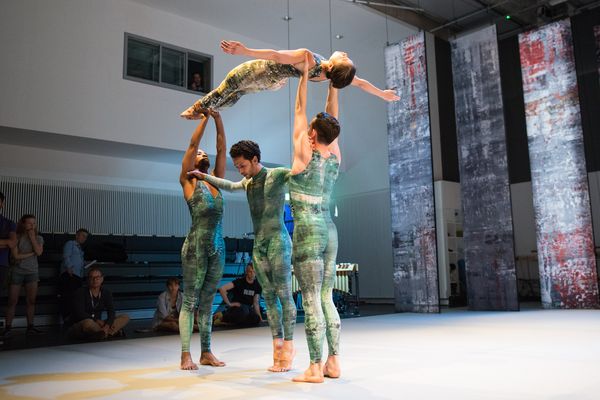
P: Thinking about the Phillips space in particular, what stands out to you as exciting or unique?
JS: One of my favorite things about Phillips is the glass windows all around. With people stopping to look in, we're going to have an audience around an audience around a performance. The thing that's nice about doing a performance in an unconventional space like this is that it eliminates the typical distance between the performers and the audience. You get to see the humanity of these beautiful beings: you hear their breath sounds; you hear their foot falls; you see their sweat. That creates an empathy and an exuberance that you can't really have in a proscenium space with a great distance and darkness separating the stage and audience.
When you see dance in this sort of venue, it changes how you look at dance forever. And it impacts the dancers as well: These event performances in unusual spaces were always my favorite because they opened a door for me as a performer that once I stepped through changed how I performed in any venue.
As a viewer, similar to with an abstract Richter painting, you're allowed to make your own decision about the meaning of the work, and perhaps you just want to be with it and observe it. Not everyone feels the same way about a subject, and that's why Merce was so drawn to keeping choreography open and abstract. I think that's what all great abstract artists have provided us: an experience, and the opportunity to have our own mind and to contemplate it.
This event format provides a very unique, one-off feeling of an experience. You know when you leave the Phillips gallery that you won't see that again.
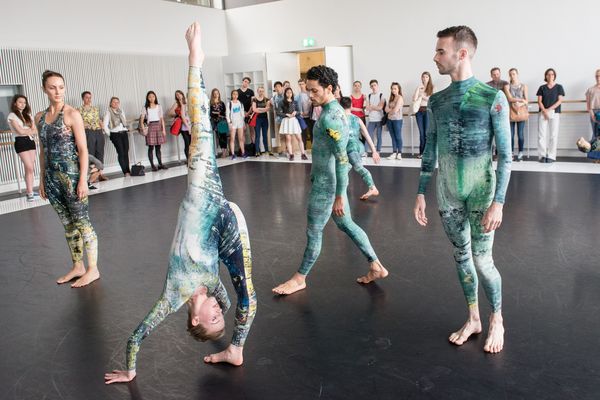
P: Going into a performance, is there a specific way in which you prepare with your dancers? Do you have any set rituals?
JS: I'll give them a warm-up class in the morning, but pre-performance the dancers will be warming up on the Phillips stage as the audience is coming in. It breaks that taboo, and the dancers will have to let go of the audience being able to see their personal rituals as they focus their energy. We will be letting people in on that process and opening their eyes to the reality of how these dancers prepare: they don't just wake up ready to dance; they have to work their tails off.
P: It reminds me of the cinematic equivalent of breaking the fourth wall.
JS: Yes, and similarly I remember doing an Event in Perth, Australia just as the sun was going down. People's heads were bobbing out of the water and they were swimming towards us to see what was going on. Children ran around us and mimicked our movements. I think Merce spent more time that day gleefully experiencing the moment and taking in the audience's participation and engagement rather than watching us dance.
I feel so grateful that I'm still able to inhabit Merce's world with people who want to share it.
